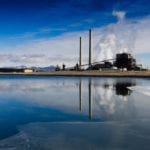The power sector should view the Environmental Protection Agency’s (EPA’s) recent drive to tighten regulations on air and water emissions as an opportunity to improve its efficiency and environmental footprint rather than as an obstacle, said EPA General Counsel Avi S. Garbow at POWER magazine’s inaugural conference on legal issues in the generation industry.
“We want you to work with us, not just you listening to us but us listening to you,” Garbow told attendees at the event in Las Vegas on Dec. 7.
The EPA’s top legal mind stressed that the agency wants to be a partner with generation companies and others in the power sector in finding ways to move forward on climate change and other environmental challenges, without handicapping reliability or power markets.
“My hope is that none of you see environmental protection as the antithesis of economic progress,” he said. “You don’t have to agree with us all the time, but that goes a long way toward dealing with us effectively.”
Win-Win Solutions
Garbow acknowledged that the EPA and many in the generation industry are far apart in some areas, especially when it comes to enforcement. Still, he called on attendees to find ways to meet the agency in the middle.
“The EPA is a reasonable partner for environmental protection,” Garbow said, stressing that the agency really does prefer to find win-win solutions for the parties it deals with and to help maximize good corporate responsibility.
Working together and being reasonable about regulations rather than hostile yields better results in the long run, he said.
Limited Discretion
Garbow also made an effort to explain that the EPA is not the freewheeling, unaccountable agency it is often made out to be. Rather, it is tightly constrained by a welter of often-conflicting statutes and court decisions that frequently leave it little choice in the direction it goes.
“In most cases,” Garbow said, “the agency does not have discretion not to act.”
The statutes the EPA operates under, such as the Clean Air Act, Clean Water Act, and other laws, were created separately at separate times under differing priorities and political environments. “The agency has to figure out ways for these to work together,” he said.
He also pointed out that much of what the EPA does is triggered by advances in science, since statutes typically require the “best available” technologies and solutions. Those solutions will change over time with the pace of scientific and technological advancement.
Garbow also stressed that the EPA is not out to handicap the free market. Rather, it tries to find ways to meet its statutory mandates in ways that work economically.
“These regulations are in place to help the market work more efficiently.”
Regulatory Priorities
Garbow then discussed the EPA’s recent regulatory updates to a wide array of areas affecting the power sector, from Coal Combustion Residuals (CCR), Effluent Limitation Guidelines (ELG), regional haze, and Cooling Water Intake, to the Mercury and Air Toxic Standards (MATS), the Cross-State Air Pollution Rule, and the Clean Power Plan.
The treatment of these regulations illustrates much of what Garbow said earlier. The EPA’s goal with the final CCR rule was to preserve state control within national minimum standards, since this is an area that has traditionally been within state supervision. The monitoring process envisioned by the rule means a lot of information the agency is not yet ready to handle, he said. That will take time.
The ELG update, Garbow noted, is an example of a rule change that was dictated by advances in technology. Since the last update in 1982, there have been both advances in control technology and significant improvements in the science around the effects of power plant effluent. That meant the rule had to be updated.
On MATS, Garbow pointed out that, no matter the final result of litigation against the rule, “the vast majority of facilities are already in compliance with the standards.”
Climate Change and the Clean Power Plan
Garbow then turned to the administration’s climate initiatives.
President Obama, Garbow said, has made direct action to address climate change a centerpiece of his second term, and the EPA has been tasked with carrying out three separate elements of that plan: transportation emissions, methane emissions from the oil and gas sector, and carbon emissions from new and existing power plants.
“The role EPA has is significant,” he acknowledged.
The EPA has made a concerted effort to design the Clean Power Plan as a federal-state partnership, with the agency laying out broad goals while leaving the states as much flexibility as possible in meeting them (Figure 1). Garbow stressed, however, that power plants are subject to the same standards no matter where they are located—the CPP doesn’t give some plants a pass while hammering others for the same performance.
- Flexible. The EPA’s Clean Power Plan building blocks are intended to leave as much flexibility for the states as possible, its General Counsel said. Courtesy: EPA
States and power plants will have plenty of time to plan ahead given the Clean Power Plan’s 15-year timeline, Garbow said. “It really depends on what the state wants to create. I encourage folks to look at ways to be creative in meeting the final rules.”
He also stressed that the EPA did not discount reliability concerns. On the contrary, “Reliability is a big feature of the Clean Power Plan,” he said. “There were a lot of concerns raised” about reliability, and this was why the EPA added additional elements to protect it.
“There are a lot of features built into the plan that are designed to preserve reliability.”
Garbow did acknowledge that anything the EPA does is bound to be controversial, with nearly every action drawing thousands, if not millions of comments.
“The public engagement with EPA,” he noted “is extraordinary.”
—Thomas W. Overton, JD is a POWER associate editor (@thomas_overton, @POWERmagazine).











